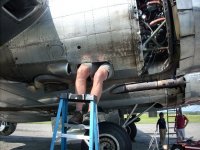I was NYSE ROP -- decades ago -- I had all the badges. I started when Filor Bullard & Smith was the major OTC options trading house! Wrote papers on options...
I was on an L1011 which blew an engine -- that was an exciting ride.
Ah, the L1011. What a great airplane by Lockheed.
There seem to be a few more issues.
Boeing 737 Max: FAA explains why it's taking so long to fix jetliner
Boeing whistleblower alleges systemic problems with 737 MAX | The Seattle Times
Boeing 737 Max: FAA explains why it's taking so long to fix jetliner
Boeing whistleblower alleges systemic problems with 737 MAX | The Seattle Times
Last edited:
Coming back to the AoA sensor: Does it really have to be a mechanical device on the outside of the plane?
Couldn't it be an internally mounted device a bit like a spirit level? What are the reasons that it is not?
At least it would be safe from bird strike that way.
Couldn't it be an internally mounted device a bit like a spirit level? What are the reasons that it is not?
At least it would be safe from bird strike that way.
From Wikipedia :
In fluid dynamics, angle of attack (AOA, α, or α) is the angle between a reference line on a body (often the chord line of an airfoil) and the vector representing the relative motion between the body and the fluid through which it is moving.
If the sensor were entirely internal to the plane how would it reference the airflow?
In fluid dynamics, angle of attack (AOA, α, or α) is the angle between a reference line on a body (often the chord line of an airfoil) and the vector representing the relative motion between the body and the fluid through which it is moving.
If the sensor were entirely internal to the plane how would it reference the airflow?
The angle of attack is dependent on the relative motion of the air. I guess it needs to be in the breeze to do that.
If you know what the normal angle of attack is (I think its generally 8 degrees in level flight please correct me if I’m wrong) it’s very easy to detect the angle of the plane with an internal sensor. You then also need air speed and air pressure. Bring those three together and I think you can compute the status of the plane - ie ok, about to stall, stalled or plunging toward the earth.
That looks like a good possible sanity check, something any complex device like this should have, but I can see where it won't detect an updraft or downdraft, an exceptional condition that I've heard of as causing a crash during landing. This could augment the current sensor(s) but not replace them. These things need MORE sensors and good integration/fusion of their signals, not one sensor replacing another.If you know what the normal angle of attack is (I think its generally 8 degrees in level flight please correct me if I’m wrong) it’s very easy to detect the angle of the plane with an internal sensor. You then also need air speed and air pressure. Bring those three together and I think you can compute the status of the plane - ie ok, about to stall, stalled or plunging toward the earth.
This is what Boeing wrote about the AOA in Oct. 2000:
http://www.boeing.com/commercial/aeromagazine/aero_12/aoa.pdf
I ran across this article while preparing for a session in a 737-NG flight simulator (I'm not a pilot, it was just for the fun of it).
In effect, at that time they considered it an auxiliary information for cross-checking with other vital flight data - a sort of sanity check, as @benb already remarked.
http://www.boeing.com/commercial/aeromagazine/aero_12/aoa.pdf
I ran across this article while preparing for a session in a 737-NG flight simulator (I'm not a pilot, it was just for the fun of it).
In effect, at that time they considered it an auxiliary information for cross-checking with other vital flight data - a sort of sanity check, as @benb already remarked.
So many angles George!
Vertical airflow next to some clouds can be very strong, why light aircraft have to keep away from them.
Interesting reading that. Strange NTSB conclusion "the flight crew's decision to fly through a thunderstorm" - when they tried to avoid them and only wound up in one because no one knew it was there....
I have gained the impression that pilots get more than their fair share of blame and of course dead ones cannot defend themselves. What if Sully Sullenberger hadn't been successful with his ditching attempt - would he have been lambasted for his decision to fly into a flock of geese?
I have gained the impression that pilots get more than their fair share of blame and of course dead ones cannot defend themselves. What if Sully Sullenberger hadn't been successful with his ditching attempt - would he have been lambasted for his decision to fly into a flock of geese?
I was on one of the two flights that abandoned their approach. From the Archives: The Delta Plane Crash
Pilots know that they should abandon the approach, but have to deal with the realities of airlines hating delay and effectively imposing dangerous KPIs on the pilots
- Status
- Not open for further replies.
- Home
- Member Areas
- The Lounge
- 737 Max
